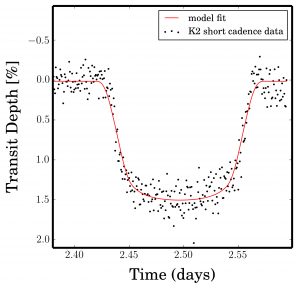This already a week old now but I thought I’d post some of the press stories. I’ve spent the last year writing a paper that was published in Nature announcing the discovery of an exoplanet smaller than Mercury. This work has taken a long time so it is great that it has finally become public.
We managed to get a lot of press attention. Some of the articles are listed below. Additionally, one of the co-authors of the paper did a great interview on Australian TV.
The information below comes from the NASA public affairs team.
The AP (2/21, Chang) reports scientists using the Kepler telescope data have discovered a planet about the size of the moon, although the exoplanet, called Kepler-37b, “orbits too close to its sun-like star and is too sizzling to support life.” It was discovered by Thomas Barclay of the Ames Research Center and it “took more than a year and an international team to confirm that it was a bona fide planet.” UC Berkeley’s Geoff Marcy said, “This new discovery raises the specter that the universe is jampacked, like jelly beans in a jar, with planets even smaller than Earth.” Alan Boss of the Carnegie Institution for Science, called the discovery a “milestone” towards finding an Earth-like planet.
The Los Angeles Times (2/21, Brown, 692K) reports Barclay said scientists are “breaking new ground” with the discovery, who noted that a total of three planets have been found in the system. While none are similar to Earth, Barclay, according to the article, claimed the “discovery is still ‘really good news’ for the search for habitable worlds…because it demonstrates that the Kepler telescope is sensitive enough to find Earth-sized planets with longer orbits ‘in the not-too distant future.'” Caltech’s John Johnson, who was not part of the study, praised Kepler for making exoplanet discoveries “blasé” with the what it has found.
The Boulder (CO) Daily Camera (2/21, Brennan, 40K) reports on the ties the mission and the discovery has to the region as Barclay said, “This project would not have been possible if not for the exquisite instrument built at Ball.” Meanwhile, Alan Gould, a co-investigator for education and public outreach for the Kepler mission, said, “The significance as far as I’m concerned is that when the mission first started it was hoped that we could find planets smaller than Mars, and we thought it might be able to find planets as small as Mercury. … So, this is momentous in that here is a planet smaller than Mercury, and it is totally due to the incredibly precise light measuring capability of the Kepler instrument.”
According to the Christian Science Monitor (2/21, Spotts, 47K), in another result from this study, “Kepler’s ability to take very precise measurements of the star’s own light helped the team develop a highly accurate estimate of the star’s size and mass.”
SPACE (2/21, Howell) notes “Barclay and his team took great care to confirm the existence of planets around Kepler-37.”
Also covering the story are Bloomberg News (2/21, Lopatto), CBS News (2/21, Harwood) “Space” website, BBC News (2/21, Palmer), Popular Science (2/21, Nosowitz, 1.3M), Wired (2/21, Mann, 798K) “Wired Science” blog, ScienceNOW (2/21, Croswell, 128K), New Scientist (2/21, Aron), Discovery News (2/21, Klotz), another Discovery News (2/21, O’Neill) article, Gizmag (2/21, Szondy), UK’s Daily Mirror (2/21, Rankin, 1.32M),PolicyMic (2/21, Marin), Scientific American (2/21, Matson, 483K), China’s Xinhua (2/21) news agency, Sen(2/21, Black), Universe Today (2/21, Atkinson), The Escapist (2/21, Bolding), Geekosystem (2/21, Chant), andGizmodo (2/21, Diaz).

